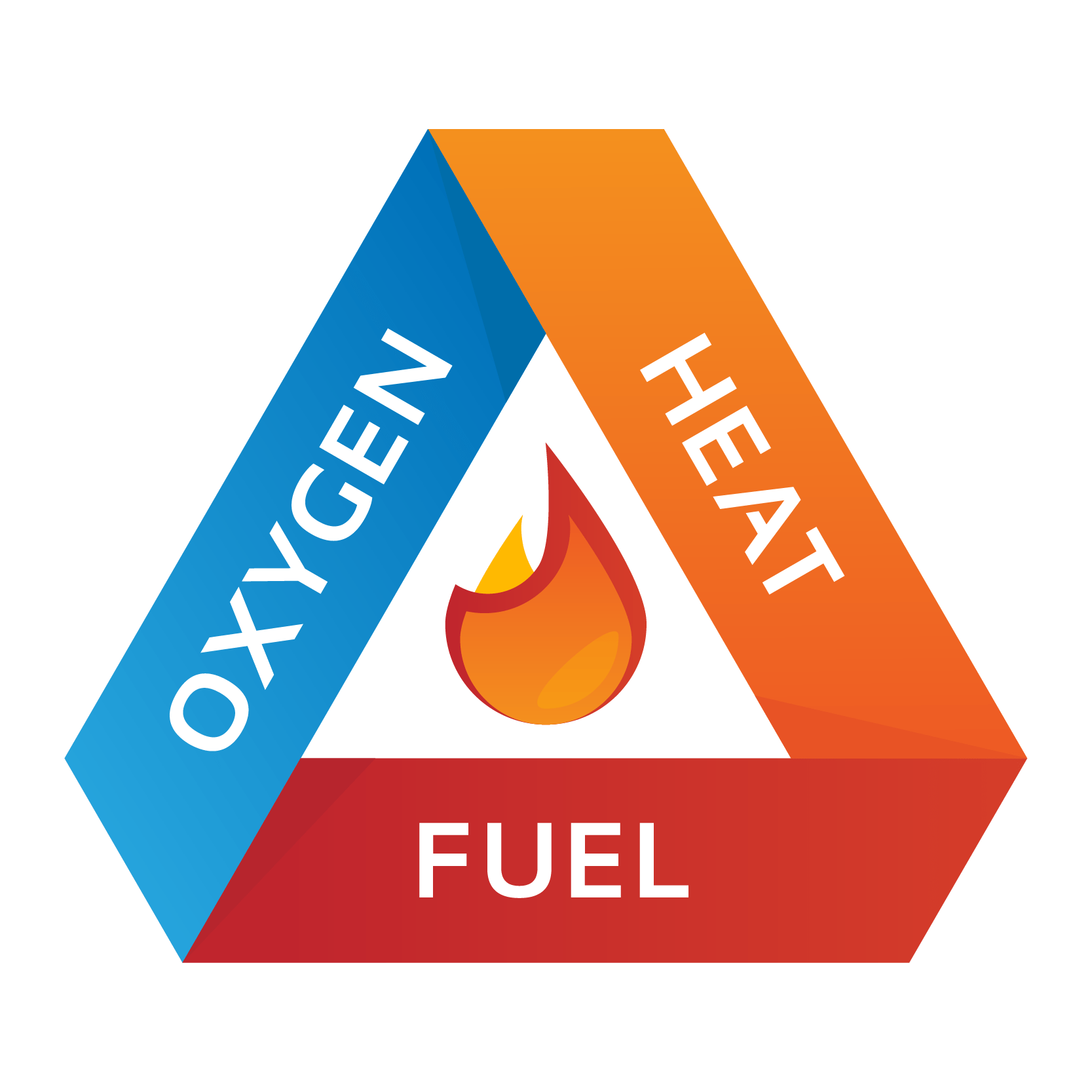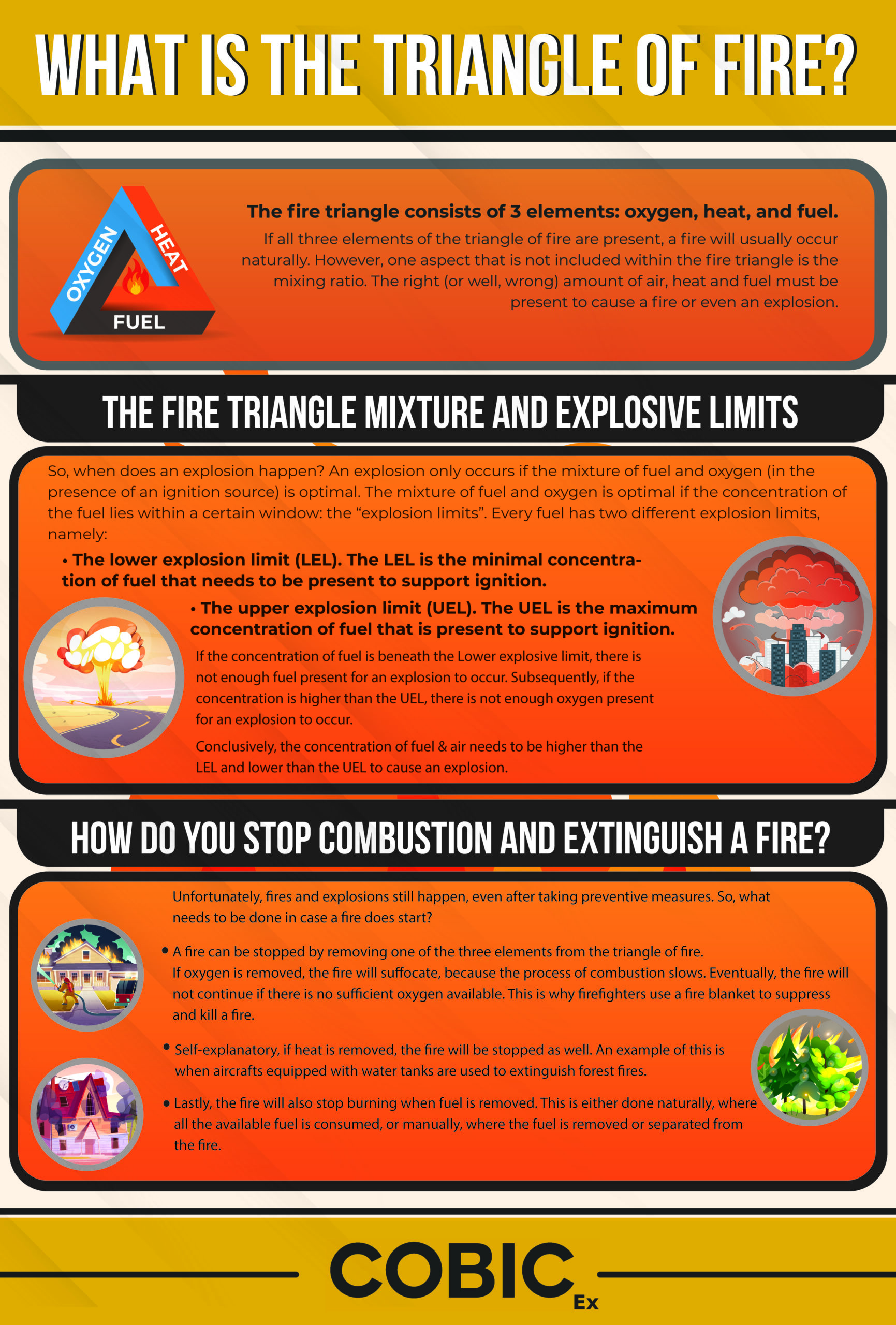Perhaps you’re familiar with the fire triangle, a concept crucial in various industries, including ATEX environments. But did you know people also know it as the combustion triangle and the explosion triangle?
Additionally, there’s the ‘fire tetrahedron,’ a more complex concept than the fire triangle, comprising additional elements.
In this blog, Cobic-ex will delve into various topics and questions related to these concepts, including ‘What is the fire triangle?’ and ‘What are its three key elements?’
What Is The Triangle of Fire?
The fire triangle is composed of three critical elements: oxygen, heat, and fuel. Heat technically represents one of the 11 ignition sources identified in EN 1127-1. Therefore, we could also describe the fire triangle as consisting of oxygen, fuel, and an ignition source. This model simplifies the understanding of the essential ingredients for most fires. When all three components are present, a fire is likely to occur naturally.
However, a crucial detail often overlooked in the fire triangle is the specific mixture of its components. For a fire or an explosion to occur, these three elements must be present in a particular ratio. This mixing ratio plays a vital role in determining whether a fire ignites. This leads us to an important question: what differentiates a fire from an explosion?

The Fire Triangle and The Explosion Triangle
Both the fire and explosion triangles share the same components, yet they differ fundamentally in one aspect: the rate of burning. The key distinction between a fire and an explosion lies in the burning rate; explosions occur at a significantly faster rate than fires. Additionally, it’s important to note that a fire can trigger an explosion, just as an explosion can lead to a fire.
The Fire Triangle Mixture and Explosive Limits
The previous paragraph highlighted the significance of the mixing ratio for fire ignition. This factor is even more crucial when it comes to explosions.
For an explosion to occur, two essential elements must be present: fuel and oxygen. An explosion only happens when the mixture of fuel and oxygen, in the presence of an ignition source, reaches an optimal level.
LEL and UEL
This optimal mix is defined by a specific concentration range known as the ‘explosion limits.’ Each flammable substance has two distinct explosion limits, which are:
- The Lower Explosion Limit (LEL) represents the minimum concentration of fuel required in the air to support combustion. Below this threshold, there isn’t enough fuel vapor to ignite.
- The Upper Explosion Limit (UEL) refers to the maximum concentration of fuel in the air that can support combustion. Beyond this point, the mixture is too rich in fuel and lacks sufficient oxygen to ignite.
If the fuel concentration falls below the Lower Explosive Limit (LEL), the mixture lacks sufficient fuel to cause an explosion. Conversely, when the concentration exceeds the Upper Explosive Limit (UEL), there is an excess of fuel but not enough oxygen to support an explosion.
Therefore, for an explosion to occur, the fuel concentration must be within a specific range, bounded by the LEL and UEL.
Preventing and Eliminating Explosive Atmospheres
Going over the explosive limit to prevent an explosive atmosphere is usually not very practical. Imagine pumping a room full of dust just to go over the UEL. Instead, plant owners focus on maintaining safety by keeping fuel concentrations below the Lower Explosive Limit (LEL). Plant owners typically achieve this through high-level cleaning and effective ventilation systems.
How Do You Stop Combustion and Extinguish a Fire?
In the realm of safety, preventing fires and explosions is paramount. To mitigate the risk of such incidents, measures such as investing in explosion-proof equipment are essential. However, despite the best preventive strategies, the possibility of a fire breaking out cannot be eliminated. So, what should you do if a fire does ignite?
A fire can be extinguished by eliminating one of the three elements of the fire triangle: oxygen, heat, or fuel.
Firstly, removing oxygen can suffocate a fire. Firefighters often use fire blankets to achieve this, as the blanket cuts off the oxygen supply, causing the fire to slowly die out due to lack of combustion.
Secondly, removing heat can also extinguish a fire. In aerial firefighting, aircraft equipped with water tanks commonly douse forest fires, effectively reducing the fire’s temperature.
Lastly, a fire will cease if something depletes its fuel source. This depletion can occur naturally when the fire consumes all available fuel, or someone can do it manually by removing or isolating the fuel from the fire.
What is the fire triangle infographic

The Fire Tetrahedron
The fire tetrahedron represents an evolution of the fire triangle concept, emerging from further research. It can be visualized as a pyramid with four elements instead of three. The critical addition to the traditional fire triangle is the chemical chain reaction.
This reaction is triggered when a material ignites, and it sustains the fire by continuously feeding the combustion process. The fire will persist until one of the elements of the fire triangle is removed, thereby disrupting this chain reaction.
While the fire triangle and tetrahedron may appear as simplistic models, their importance cannot be overstated. They are fundamental in both preventing fires and in strategies for effectively extinguishing them.
We trust that this blog has provided you with a deeper insight into topics such as the fire triangle, the explosion triangle, and fire extinguishment techniques.
For additional information or inquiries related to fire safety, explosions, intrinsic safety, or ATEX regulations, please do not hesitate to contact us at info@cobic-ex.com.




